Special Mid-Month Issue Ides of March, 2013 |
|---|
http://www.purewatergazette.net |
| We hope you'll read the Pure Water Gazette's "Today's Top Water News" section. New articles appear daily. Some examples of recent posts are included in his issue |
In the News
In spite of widely published reports of pharmaceuticals contaminating public water supplies, more than half of the medical facilities examined in a recent New York study were discovered to still be following the irresponsible practice of disposing of drugs by flushing them down the toilet.
More from the Pure Water Gazette.
We’re Learning to Use Water More Wisely (But We Still Have a Long Way to Go)
by Hardly Waite
In spite of talk of water shortages and the dire consequences of global over-consumption, it is encouraging to note that in some areas we’re getting smarter and making better use of our water resources.
While there is an assumption that humans will continue to use more and more water, there are signs that we’re learning to use water more wisely in some areas.
For example, improvements in irrigation techniques have resulted in considerably less water being lost to evaporation. And even the compulsion to maintain lush lawns in areas where grass was not meant to grow seems to be losing its stranglehold on the American brain.
Another big positive for sensible water consumption is that Americans are eating less beef. The eating of cattle is one of our most outrageously wasteful practices when it comes to water consumption. A move toward a plant-based diet not only leads to much less consumption, but it is one of the most powerful anti-pollution steps we can take.
We have also made great advances in creating better water-using appliances. Common home appliances like washing machines and toilets now do a better job while using less water than their predecessors. Industry has also learned to save money by saving water and many commercial devices use remarkably less water than previous models.
Another important advance that we are making in conservation is in the reuse of treated wastewater. Municipal reuse of wastewater is still in its infancy, but more and more cities and industries are converting to direct or indirect reuse of their treated waste stream. This takes time for people to accept. Although all the water we use is recycled, the idea of drinking today what was yesterday’s sewage doesn’t sit well with us. As the practice becomes more common, though, its acceptance will accelerate and wastewater reuse will probably become our most powerful water conservation tool.
Sprite shower filters make you sing better.
The Hanford Question
by Janice Kaspersen, Editor, Stormwater.
Since its inception in the 1940s as a secret source of nuclear weapon grade uranium, the Hanford Nuclear Reservation has been one step away from total disaster. Now, its bulging waste storage tanks are leaking into area drinking water and into the Columbia river.--Hardly Waite.
The Hanford Nuclear Reservation, a site in Washington state where nuclear waste is stored, has been in the news quite a lot in the last few weeks. First, the Department of Energy announced that as much as 300 gallons of radioactive waste is leaking from the site each year, then the state’s governor confirmed that six storage tanks (of 177 at the site) are leaking. This is a problem in any number of ways, but one big concern is for the groundwater and surface water—particularly the Columbia River—that the leaking material enters.
According to this article, which describes a reporter’s tour of the area, about 200 square miles of contaminated groundwater already underlies the site. Hanford acknowledges that over the years, 67 of its tanks—not including the six currently in question—have leaked. The tanks range in capacity from 55,000 to 100,000 gallons, and waste is moved from the bad ones into more secure ones. However, the volume of nuclear waste has exceeded what the tanks can contain, and some of it is held in other facilities or in trenches.
From the early 1940s to the late 1980s, Hanford was the site of plutonium production for use in nuclear weapons. The site was chosen in part for its isolation, but also because water from the Columbia River could be used for cooling the reactors. Some of the basins that were used to hold spent uranium rods are located only about 400 yards from the river.
A vitrification plant is currently under construction at Hanford, designed to turn all of the waste—sludge, solid, and liquid—into glass, which will be more stable and can be more easily transported. An optimistic estimate for the plant to be up and running, though, is 2022.
Source: Stormwater.
See also "At the Hanford Nuclear Reservation, a Steady Drip of Toxic Trouble" from The Daily Beast.
The controversial oil production practice known as fracking consumes great amounts of water–four million gallons and more per well. A significant percentage of that water comes back as immediate flowback or later as “produced water.” This water is sometimes injected untreated into deep disposal wells, but there are now efforts to treat the returned water for reuse in other fracking ventures. Treatment of frack water is becoming a big and profitable business.
Please read Private frack water treatment expanding in Marcellus region by Matt Richmond in the Pure Water Gazette.
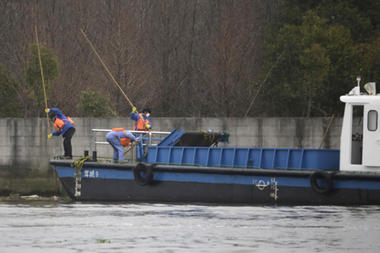 |
|---|
When Chinese pigs die of disease, farmers routinely toss their bodies into the nearest river. The Huangpu, Shanghai’s drinking water source, gets more than its share. More than 2,800 pig carcasses were discovered recently in the Huangpu River, which feeds Shanghai taps. |
Dead Pigs in Shanghai Water Supply Don’t Ring Alarm Bells for Chinese Officials
by Peter Ford, Christian Science Monitor
Answer: When the discovery is made in China.
The Shanghai water bureau, which oversees the water consumed in China’s largest city, was insisting on Monday that tap water derived from the Huangpu River met national standards despite the presence of the decomposing pigs.
All I can say is that I am glad I live in Beijing, not Shanghai.
Truly disgusting photographs of bloated porcine carcasses on a riverbank have appeared in many Chinese papers and websites, drawing attention to what seems – believe it or not – to be a relatively common occurrence.
When pigs die of disease, farmers who cannot be bothered to bury the animals just toss them into the nearest river.
Local residents of one pig-rearing village upstream from Shanghai told the national broadcaster China Central Television on Sunday that disposing of dead pigs in the river was a common practice. “After the pigs died of illness, [they] just dumped them in the river … constantly. Every day,” one villager said.
“They are everywhere and they smell very bad,” the villager added.
Thousands of pigs in the Shanghai area have succumbed to epidemic disease in recent months, according to the Jiaxing Daily, a government-run paper in a hog-raising region southwest of Shanghai.
Last week the paper reported that more than 18,000 pigs had died since the beginning of the year in Zhulin, a village in the Jiaxing district. It was not immediately clear how many of them had been legally disposed of and how many had been thrown into the river.
But in a report last week, the paper quoted one pig farmer as saying that “when things are busy,” he and his fellow farmers do not bother to call the local veterinary services to take the corpses away and just “throw them away where we can.” In the summer, he added, the smell of rotting meat is sometimes so strong that villagers cannot open their windows.
More worryingly, the paper said, many readers had called the editorial desk’s hotline to report pig carcasses abandoned by the roadside or in water channels that had mysteriously lost their hind legs overnight.
“What if they were cooked in a restaurant?” the newspaper article wondered.
Source: Christian Science Monitor
Countertop Reverse Osmosis
Editor's Note: This piece is adapted from a full-issue presentation of countertop reverse osmosis units that appeared in July 2011. It is archived here if you'd like to read the whole thing.
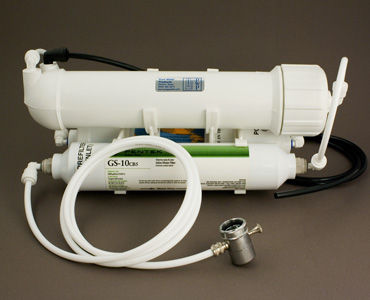 |
|---|
The compact countertop reverse osmosis unit is one of the most efficient, practical, and cost-effective of all water treatment devices. It is a simple water-making machine, with no frills or unnecessary parts. Both initial cost and upkeep expense are low.How it works: The metal diverter valve in the foreground screws onto the sink faucet. It delivers water to the pre-filter (green-labeled filter), which removes chlorine and chemicals and sends the water on to the RO membrane (large vessel on top). The black tube from the membrane carries the brine (reject water) to drain into the sink, and the white tube beside it sends the permeate (treated water) to the post-filter in back. It exits the post filter through a white tube (not visible in picture) from which it is collected in the user's container. |
The simple countertop reverse osmosis unit is a much under-valued item. Dollar for dollar (or penny for penny, because countertop RO units don't cost a lot), countertop RO is the most efficient and economical way to produce top quality water.
By way of definition, what sets countertop RO apart from an undersink RO unit, more than the fact that it often sits on the countertop, is the absence of a pressurized storage tank and the incidental small parts that the pressure tank requires. Countertop units produce water, slowly, to be collected in a pressure-free container.
Two styles of countertops are commonly sold. One is a complete-in-itself system that has its own non-pressurized storage bottle built into the unit. This style can itself range from relatively simple to very complicated. Some units require electricity and have built-in pumps and electronic shutoff devices; others run on water pressure only and use a simple float valve as a shutoff. Both simple and complicated usually have the working parts enclosed in a plastic case which can cause space-related design problems and make servicing the unit a challenge. (Illustrations of the tank-style countertop can be found in our July 2011 issue.)
The second style of countertop reverse osmosis is a simpler design that does not provide a storage system of any type. These units simply produce water through an outlet hose to be collected in a container of the user's choosing. They are bare-bones systems that have no extraneous parts. The entire apparatus is devoted to producing water, and appearance is usually not a big consideration.
The unit pictured above is one of Pure Water Products' standard countertop RO configurations. It's a simple, three-stage RO unit that uses standard inline carbon filters and a conventional standard-sized membrane. All parts are readily available and easily replaceable. It produces water at the rate of about 2 gallons per hour.
Below is our most popular countertop RO unit. You'll note that it doesn't look like a countertop RO unit. There are many advantages to the full-sized unit. These include the wide range of filter cartridges available, easily obtained parts and replacements, and the fact that it can be easily converted for undersink use at a later date.
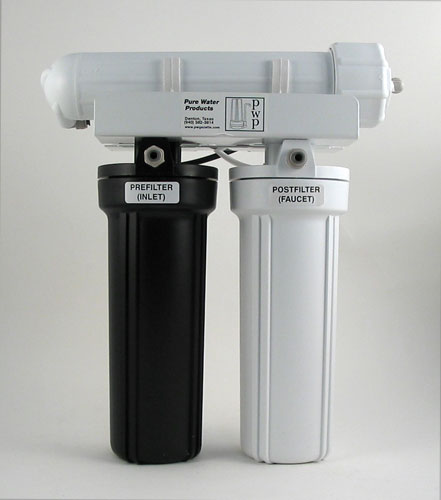 |
|---|
Pure Water Products Style A Countertop Reverse Osmosis Unit This classy countertop is a simplified version of our "Black and White" undersink unit. It is pictured here without the diverter inlet and drain and product tubes. It uses the same basic setup as our undersink unit, except the membrane, which is a Filmtec 50 GPD for faster production. As with undersink Black and White units, we'll make parts changes: if you want a couple of extra stages or cartridge or membrane substitutions, just ask. |
Applications for Countertop RO Units
The tank-attached countertop units are limited to one application: sitting on the countertop beside the sink and making drinking water.
For tankless units, however, the uses are limited only by your imagination. Here are some of the more frequent applications:
The most common use is as a bottled water maker. The unit is installed to the sink faucet and allowed to produce water into a bottle. When the bottle is filled, you turn the unit off. You can leave it in place or remove it. It can also be installed in a laundry room or patio--anywhere there's a water source and a drain.
As an aquarium filler. Water is collected in a large container for subsequent addition to the aquarium. An auto shutoff system can be supplied on request that turns the unit off when the container is full.
As an outdoor pond filler. The unit can be allowed to fill the pond when it is turned on manually or it can be installed to top off the pond and shut off automatically when the pond is full. We can supply the unit with a garden hose connection that will allow the user to produce RO water from a garden hose.
To provide final rinse water for a spot-free car wash. The water must be captured in a small tank, then pumped to provide pressure for the car wash. A deionizing cartridge can be added to provide zero-TDS water if desired.
To provide high quality water for plants, either in small outdoor gardens or greenhouses. This application also requires capturing then pumping the water to the point of use, although small drip systems could be designed that take water directly from the RO unit.
See countertop reverse osmosis units on our main website.
Chemicals used to treat your drinking water might be hurting you, environmental group saysReported by Gil Aegerter, for NBC News |
Editor’s Note: There’s nothing new about trihalomethanes–we’ve been aware of the problem of disinfection by-products for decades– but the Environmental Working Group report is important because it explains the scope of the problem and underlines how little we are really doing about it. –Hardly Waite.
Chemicals used to treat drinking water actually might raise the risk of cancer or cause other health hazards by creating toxic byproducts that need tighter federal regulation, according to an environmental advocacy group.
Fair Warning reports that the Environmental Working Group, a Washington, D.C.-based advocacy organization, also wants the government to reduce the need for chemical treatment by cleaning up sources of public drinking water.
The Environmental Working Group says the problem is that chlorine and other chemicals that public utilities add to drinking water to kill microorganisms can react with other material – such as sewage and manure – to create hundreds of toxic byproducts, many of which aren’t regulated at all.
According to Fair Warning’s post:
Researchers analyzed results from water quality tests done in 2011 at 201 large municipal water systems that serve more than 100 million people in 43 states. They found trihalomethanes, a byproduct of chlorination, in every system. The EPA calls some members of this class of chemicals “probable human carcinogens” and studies have linked them to bladder cancer, birth defects and miscarriages. However, only one water treatment system exceeded the EPA’s limits for the chemicals, which was set at 80 parts per billion in 1998.
But the report argued that the EPA’s limits are too lax, citing several studies linking even lower levels of the chemicals to health problems. For example, in 2011 a French research team analyzing data from three countries found that men exposed to more than 50 parts per billion of trihalomethanes [try-hal-o-MEH-thanes] had significantly increased cancer risks.
You can read the full Environmental Working Group report here.
Read more from Fair Warning here.
Pharmaceuticals and Personal Care Products
Pharmaceuticals and Personal Care Products (PPCPs) include drugs and personal care cosmetic products as well as household cleaners.These are many and diverse. They include both synthetic and natural products, prescription and over-the-counter concoctions, plus medicines and grooming products for animals. Also included are natural and synthetic hormones and antibiotics, including natural hormones excreted by animals and humans.Some very common examples include aspirin, ibuprofen and caffeine. Some exist in very small amounts. To keep things in perspective, a cup of coffee contains about one million times the amount of caffeine that has been detected in some water samples. Other common examples of drugs and PPCPs found in water are detergents, household cleaning agents, insect killers and repellants, etc.
In a word, there are so many items in this category that generalizations about their effects or how to remove them from water are at best simply generalizations.
Although it seems from media reports that the presence of drugs and PPCPs in water is on the rise, it is likely that increased reporting due to improved detection methods is in part responsible. In any case, presence of drugs and cosmetic items are being reported frequently now in ppt (parts per trillion) amounts as well as micrograms and nanograms.
Because of the tiny amounts being detected, there is no reason to assume that human health is being affected. However, there is now strong evidence that behavior changes in fish can be caused by drugs in the water even in tiny amounts. Also, “feminization” of male fish near sewage release points has been reported, and the supposition is that drugs and hormones are the cause.
Water Treatment: There is obviously no way to determine the preferred treatment method for every possible drug, cosmetic, or household chemical that might be in water, but it is safe to assume that standard water treatment techniques can be effectively used in most instances. Some contaminants can be oxidized by chlorine, ozone, or hydrogen peroxide; and granular carbon, the standby tool for most chemicals, can be used to adsorb a large percentage of the contaminants in this category. Reverse osmosis membranes will screen out chemicals with larger molecular weights (over about 100 daltons). More advanced oxidation processes, though expensive, are also available for items not removed by conventional treatments.
From a residential water user’s standpoint, an undersink reverse osmosis unit (which contains pre- and post- carbon block filtration) is the obvious best choice for pharmaceutical-free and PPCP-free drinking water. A good multi-stage carbon filter would also be an excellent choice.
Source Reference: Water Technology.
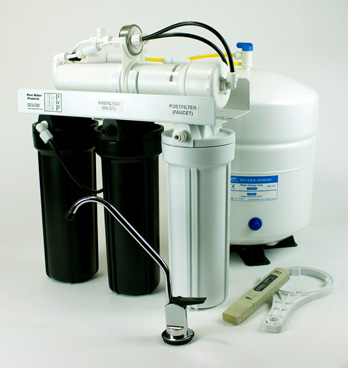 |
|---|
Black and White The Superb 4-stage Black and White undersink Reverse Osmosis unit. Built by humans in America, envied by robots the world over. Details. |
Water News Briefs of Lesser Magnitude:
March 11 was National Plumbing Day. If you missed it, take heart. March 18 to 24 is EPA-designated Fix A Leak Week,
The Riverside-Brookfield boys water polo team has added new players and is expected to improve on last season’s 4-of-25 record, although they have lost the first six games of the current season. Details.
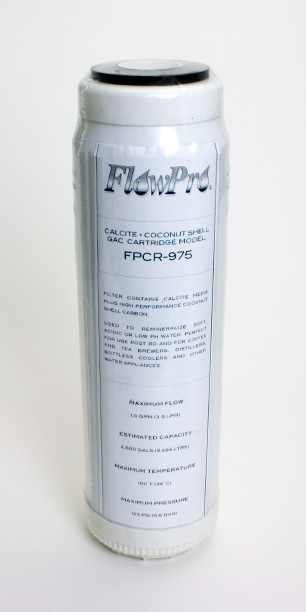 |
|---|
Above is an "axial" style media cartridge. It contains calcite, a sacrificial medium that raises pH and adds minerals to low pH water, plus coconut shell carbon for taste/odor and chemical treatment. Its most common application is as a reverse osmosis postfilter. More information. Go here on our main website for a complete listing of filter cartridges in this size. |
Early March Water News
The Pure Water Gazette features a top water news story each day. Here's what you missed in the first half of March if you haven't been reading the Gazette:
 |
Water Treatment 101: Raising the pH of Acidic Waterby Pure Water Annie Technical Wizard Pure Water Annie Describes How to Deal with Low pH Water |
|---|
This acticle isn't about the popular gadgets marketed as "ionizers." It is about the standard strategies used by water treatment professionals to raise the pH of acidic waters, most often well water, for aesthetic improvement, for the protection of plumbing parts, or to assist in other water treatment procedures such as the removal of iron and manganese.
Treating low pH is pretty straightforward. Two standard techniques are used: filtration and injection.
Filtration involves sending the water to be treated through a bed of a granular sacrificial medium which dissolves slowly and adds calcium carbonate to the water, thus buffering the acidity and raising the pH. The most commonly used medium for this process is calcite—a natural granular substance that provides a relatively mild upward bump in pH. Calcite is a simple substance, actually crushed rocks. It is sometimes mixed with a small amount of another standard medium called Corosex which has a stronger effect on increasing pH.
Most filters for acid neutralization are backwashing filters, like the one pictured below, but if the water is very clean—such as in post-treatment for large reverse osmosis units—in/out style upflow filters can be used. (Calcite is also available in cartridge form for post treatment for undersink reverse osmosis units.)
| At right, a backwashing calcite filter. The domed hole near the top allows the sacrificial medium to be added. |  |
| At right, a peristaltic metering pump to deliver a soda ash solution to raise the pH of acidic water. | 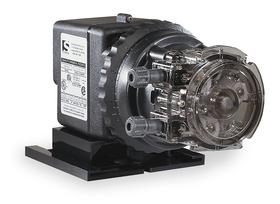 |
A small disadvantage of calcite treatment is that it raises the hardness of the treated water slightly. This is of no concern unless the water being treated is already very hard.
The second standard pH increase strategy is injection into the water stream of a small amount of a pH increasing substance.
Soda Ash is the most commonly used pH increaser, but a product called caustic soda, which is about a 30% stronger pH increaser, is sometimes preferred, especially in swimming pool treatment.
Soda ash is delivered via a small injection pump, usually electric, that sends a diluted solution of the product under pressure into the water line.
The advantage of injection of soda ash over calcite filtration is that it does not add to hardness and it gives a more potent increase in pH. It can be used to treat water in the 5.0 range, whereas calcite filtration does not give sufficient increase to very acidic water.
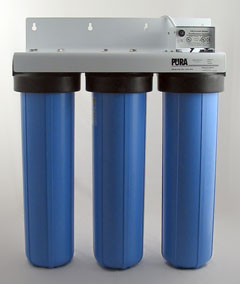 |
|---|
| The full-size Pura UVB3 whole house treatment unit has sediment filter, carbon block filter, and UV lamp built into a single unit. Our website purauv.com features all models and all parts for plastic Pura UV units. |
Pure Water Gazette Numerical Wizard Bee Sharper Reviews Important Numbers You May Have Missed |
 |
|---|
Water Regains Its Place as America's Drink
by B. Sharper
Editor’s Note: Ms. Sharper reports recent news from a variety of sources (see The Atlantic and Beverage Digest)that water is once again on top as the most popular beverage in the United States. – Hardly Waite.Percentage increase in the amount of water consumed by the average American vs. 15 years ago — 38%.
Per capita US annual consumption of of soda in 1998 — 54 gallons.
Per capita US annual consumption of water in 1998 — 42 gallons.
Per capita US annual consumption of soda in 2013 –44 gallons.
Per capita US annual consumption of water in 2013 — 58 gallons.
Per capita US annual consumption of water in 2013 in ounces — 7,242.
Per capita US annual consumption of water in 2013 in cups — 928.
Year in which soft drinks peaked in popularity in the US — 1998.
Estimated total annual American consumption of all liquids, in gallons — 180.
Estimated total annual American consumption of all liquids, in kegs — 11.
Estimated total annual American consumption of all liquids, in bathtubs-full — 4.
Estimated total annual American consumption of all liquids, in 180-gallon aquariums-full — 1.
Percentage increase in American bottled water consumption since 2001 — 50 %.
Percentage of US bottled water market now held by Coca Cola — 13%.
Percentage of US bottled water market now held by PepsiCo – 10%.
Percent increase in wine consumption in the US during the past decade — 20%.
Percent decrease in beer consumption in the US during the past decade – 12%.
Cups of light yellow or colorless urine that you should put out each day if you are drinking enough water, according to the Mayo Clinic — 6.3.
Here are some sections on the Occasional's website that you will want to visit:
Links to Pages about Water and Water Treatment
New Products from Pure Water Products
Pure Water Annie's Glossary of Water Treatment Terms
The Pure Water Occasional is a project of Pure Water Products. Please visit our websites: Main Website: www.purewaterproducts.com This site features our full range of products, plus instructions, technical articles, product manuals, and more. The Occasional's Website: www.purewateroccasional.net. In addition to archiving back issues of the email Occasional, this site houses a sizeable section about water contaminants, a "how things work," series, a new products section, a glossary of water treatment terms, and, "much, much more." Other Pure Water Products Sites: www.purauv.com To contact us by phone, please call 940 382 3814.
|
|---|
